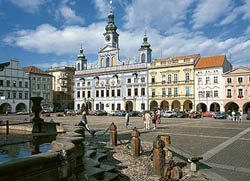
In the center of Č. Budějovice, monumental sculptures attract attention
 |
"It still holds true that the sculptures are placed as a dialogue with the architecture, residents, and visitors of the city," he reminded, highlighting the main idea of the concept. His work titled V-thinking attracts the most attention in the central Přemysl Otakar II Square. It is more than four meters tall and features a head that one can enter, "to think into," thus placing the visitor in a state of thinking according to the author. Thanks to glass apertures made of non-recyclable bottles at the top of the head, the illusion of a small cathedral space with stained glass is created.
The installation of the sculpture was quite complex, weighing 4.5 tons, so the event organizers had to call in a large crane. "The head had to be laid on its side, it was not possible to transport it upright. The maneuvering was quite tense, but it was successful, especially thanks to the sponsor of the export and installation of the sculptures, DV Stavu," described Trpák. The installation of the yellow octopus Eliska in the Blind Arm of the Malše River was also relatively complex. The five-meter sculpture weighs over 300 kilograms. First, a structure had to be built in the river, to which Eliska was secured.
In front of the town hall is the sculpture Little Martian by Jaroslav Rona, presented as a dialogue. The bronze Martian, who is lost and crying, is placed directly on the sidewalk without a pedestal, as if it just sat down there. Another sculpture in the square is Archimedon by Lukáš Raise. This organic sculpture, with its curves in contrast to the industrial material of pipes, creates an interesting tension.
In the park by the swimming stadium, visitors will also find Drapák by Jaroslav Koléška. The name is derived in meaning as well as in form from a machine, raising the question of whether it resembles a machine from the early 20th century or a machine from the future.
On Tuesday, the work of Jakub Flejšar, who exhibits annually, will also appear at the Budweis hotel. A seated figure composed of sticks. The structure of sticks that Flejšar has been shaping into human figures for several years takes on monumental proportions in this sculpture of a seated man. Its placement at the hotel can enrich both the sculpture and the architecture and connect to the old tradition of sculptures on building facades, Trpák explained.
According to Koléška, cities and towns are heading down the wrong path with so-called sculptural symposiums. "These are work camps where everything is about anything but sculptures. Communities receive pseudo-sculptures for food and accommodation, which they place in the best spots in the city," he told ČTK. He believes that if municipalities decided to hold a competition for a sculpture from time to time, they would receive a quality piece that would function in the space for centuries.
The English translation is powered by AI tool. Switch to Czech to view the original text source.
0 comments
add comment










